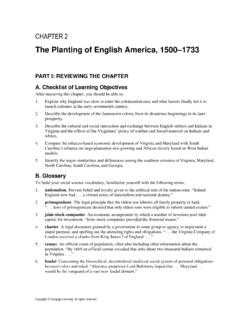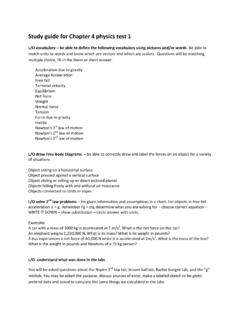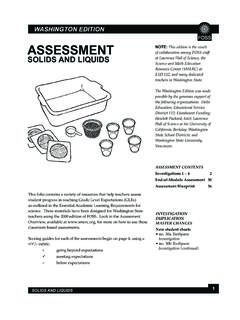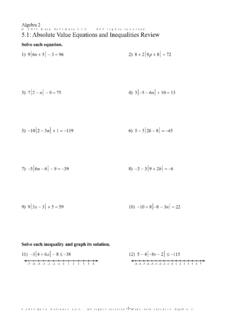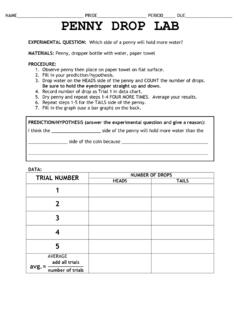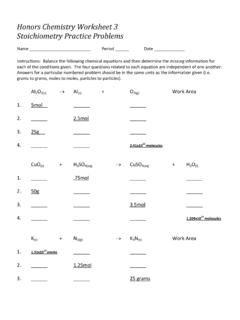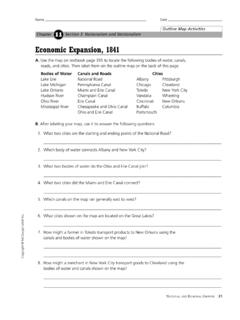Transcription of Floating Leaf Disk Assay - North Thurston Public Schools
1 Class Copy! Class Copy! Floating leaf disk Photosynthesis Lab Introduction: Photosynthesis is a process that converts carbon dioxide into sugars such as glucose using energy from the sun. When light is absorbed by pigments in a leaf , the energy absorbed is used to incorporate the carbon dioxide into organic molecules in a process called carbon fixation. The process of photosynthesis can be expressed by the following word equation and chemical equation. Light Energy Carbon dioxide + Water Glucose + Oxygen 6 CO2 + 6 H2O C6H12O6 + 6 O2. In this lab, you will be using leaf disks, to Assay the net rate of photosynthesis under various lighting conditions. leaf disks normally float, however when the air spaces are infiltrated with carbon dioxide, the overall density of the lead disk increases and the leaf disk sinks. When sodium bicarbonate is added to the water, the bicarbonate ion acts as a carbon source for photosynthesis causing the leaf disks to sink.
2 As photosynthesis proceeds, oxygen is released into the interior of the leaf , which changes its buoyancy causing the disk to rise. Since cellular respiration is taking place at the same time in the leaf , the oxygen generated by photosynthesis is consumed. As a result, the rate that the disks rise is indirectly proportional to the net rate of photosynthesis. Purpose: To observe the rate of photosynthesis under different lighting conditions (light, ambient light, dark). Question: Which kind of light will produce the fastest rate of photosynthesis? Prediction: In your notebook, record your prediction. If ..then .because . Materials: - Sodium Bicarbonate (baking soda). - Liquid Soap - Syringe - leaf - Hole Punch - Timer - Light Source (Compact Fluorescent/Incadence). - Stir sticks - Plastic cups - Beakers - Tin Foil Class Copy!
3 Class Copy! Procedure: 1. Label 3 plastic cups with the following: Light, Ambient Light and Dark 2. Copy the following chart in your notebook. Light Ambient Light Dark Time # of leaf disks Time # of leaf disks Time # of leaf disks (min) Floating (min) Floating (min) Floating 1 1 1. 5 5 5. 10 10 10. 15 15 15. 20 20 20. 25 25 25. 3. Obtain 300 mL of bicarbonate solution. (It contains 1/8 tsp of sodium bicarbonate). 4. Add 1 drop of soap to the bicarbonate solution. If your solution generates excessive suds, add more water and bicarbonate. 5. Hole punch 30 uniform leaf disks in texture and thickness avoiding major leaf veins (10 for each trial). 6. Remove the plunger of the syringe and place 10 leaf disks in the syringe barrel 7. Replace the plunger being careful not to crush the leaf disks. Push on the plunger until only a small volume of air and leaf disk remain in the barrel 8.
4 Draw a small volume of the sodium bicarbonate solution into the syringe. Invert the syringe and tap the syringe to suspend the leaf disks in the solution. 9. Push the plunger removing as much air a possible from the syringe. 10. Hold a finger over the syringe opening and draw back on the plunger to create a vacuum. Hold this for 10 seconds while swirling the syringe to further suspend the leaf disks in solution. 11. Let off the vacuum and repeat step 8 if needed 2-3 more times until all leaf disks sink. If leaf disks do not sink, add more soap to the bicarbonate solution. 12. Pour the disks and solution into the labeled cup 13. Add the bicarbonate solution until the cup is full 14. Place the cup under the corresponding light conditions and begin timing. 15. Record the number of Floating disks at the end of each time period in the table in your notebook.
5 Keep time for 25 minutes. Gently swirl the cup with a stir stick to dislodge any disks that are stuck to each other or on the side of the cup 16. Repeat steps 5 15 for the other lighting conditions. Do this while you are waiting for your time. 17. For dark trial, wrap a beaker with tinfoil to cover the plastic cup when not taking observations. For the light trial, place the plastic cup under the lamp. Class Copy! Class Copy! Conclusion (answer these questions in your notebook using complete sentences): 1. In your notebook, graph your results for all three trials on one graph. Label the graph, both axes and provide a legend to distinguish each trial. 2. What was the rate of photosynthesis for each light source? How many leaves floated/minute? 3. What was the role of the sodium bicarbonate in this experiment? 4. Which trial resulted in all the leaf disks Floating the fastest?
6 Explain why you think this happened. 5. Explain the process that caused the leaf disks to rise. 6. If the leaf disks were boiled, what kind of result would you expect? Hint: think about the enzymes that assist this reaction. 7. How does light intensity affect the rate of photosynthesis? 8. Design an experiment to investigate a different variable in the rate of photosynthesis. Be sure your investigation includes the following: Logical steps to do the plan One manipulated variable One responding variable Two controlled variables How often measurements should be taken and recorded Write your investigation in your notebook. Be sure to include your investigative question. Class Copy! Class Copy! Class Copy! Class Copy! Conclusion: [ C]. Assessment Purpose/Conclusion Observation Analysis /1 [C] /2 [T/I] /7 [K/U] /1 [C] /4. [T/I].
7 /2 [C] /6 [T/I] /7 [K/U] /15 Total Sample Observations: [2 T/I]. Light Ambient Light Dark Time # of leaf disks Time # of leaf disks Time # of leaf disks (min) Floating (min) Floating (min) Floating 1 0 1 0 1 0. 5 3 5 0 5 0. 10 7 10 0 10 0. 15 10 15 2 15 0. 20 10 20 2 20 0. 25 10 25 3 25 0. 30 10 30 5 30 0. 35 10 35 6 35 0. 40 10 40 7 40 0. 45 10 45 8 45 0. 50 10 50 10 50 0. 55 10 55 10 55 0. 60 10 60 10 60 0. Predictions: Class Copy! Class Copy! How will the different light conditions affect the rate of Floating leaf disks? - light will increase the rate of photosynthesis, should be reflected in the rate of disk rising - no disks should rise in dark since photosynthesis requires light Qualitative Observations: - leaf disks did not sink even after agitation, added more soap ~2 drops - leaf disks stuck to the edge of the cup and did not sink - disk required 3 calibrations in syringe - leaf disks are approximately uniform - more sodium bicarbonate was added until the disk sank 2.
8 What was the role of the sodium bicarbonate in this experiment? [1 K/U]. - carbon dioxide source 3. Which trial resulted in all the leaf disks Floating the fastest? Explain. [1 K/U]. - the disks exposed to light source- faster rate of photosyntheis - CO2 is consumed and O2 is generated and leaves the disk 4. Explain the process that caused the leaf disks to rise. [1 K/U]. - Photosynthesis converts the CO2 to O2. - O2 occupying the gas spaces in the leaf causes the leaf to rise 5. If the leaf disks were boiled, what kind of result would you expect? Explain. [1 K/U]. - all the leaf disks would sink. There would be no spaces for gases. - Photosynthesis would not occur since the proteins would be denatured and not functional 6. How does light intensity affect the rate of photosynthesis? [1 K/U]. - light affects the rate of photosynthesis, increasing it proportional 7.
9 The same experiment was conducted where 10 leaf disks were placed in a sodium bicarbonate solution and placed in the light. Every minute, the number of Floating disks were counted and recorded. After 14 minutes, the leaf disks were moved into the dark and the number of Floating disks were recorded every minute. Below is a graphical representation of the data. [3 T/I]. Class Copy! Class Copy! # of leaf disks Floating 10. 8. 6. 4. 2. 0. 0 5 10 15 20 25 30 35 40 45 50. Time (minutes). a. Why did the leaf disks begin to sink after being placed in the dark? there is no gas in the leaf disk leaf disks began to sink as cellular respiration was occurring and the O2 generated by photosynthesis which caused the disk to rise is being consumed b. What could the rate of leaf disks sinking be correlated to? cellular respiration c. Using your data, what can you deduce about the intensity of light used to obtained the data in the graph?
10 The intensity of light was similar to the lamp used as the rate of photosynthesis or the rate of rising disks is similar 8. Design an experiment using the same setup to investigate a different variable in the rate of photosynthesis. Explain what you are planning on testing, how you would collect the data and how you would interpret the results. [2 T/I]. - testing different carbon sources, concentrations of carbon sources, light conditions, rate of cellular respiration , different plants for leaf disks, temperature Conclusion: [ C]. - light intensity affects the rate of photosynthesis, rate can be calculated Class Copy! Class Copy! TEACHER NOTES: Course: SBI 4U. Strand: C. Metabolic Process Expectations: , , , , , , Placement in Course: This lab examines photosynthesis using an inquiry approach. Should be placed after basic concepts of photosynthesis have been covered.
